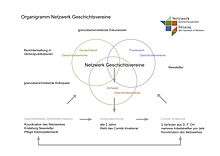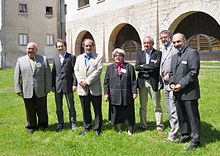Network of history associations
| Network of history associations | |
|---|---|
| logo | 
|
| begin | 2012 |
| Project management | Markus Moehring |
| Office | Dreiländermuseum |
| Website | Network history clubs |
The history associations network is a trinational association of historical associations on the Upper Rhine. For a more precise geographical definition, the term network of Upper Rhine history associations or three-country network history associations is used. The network is open to all history associations on the Upper Rhine . The members come from Germany , France and Switzerland .
Beginnings of the network
Over 10,000 people are organized in history associations on the southern Upper Rhine. You volunteer to come to terms with local and regional history. There are over 200 clubs in Alsace , Baden , Northwestern Switzerland and the Palatinate . There was little knowledge of the existence of other associations and their thematic work. The cooperation of historical societies began in 2003 at a conference in the Dreiländermuseum (then Museum am Burghof) on the initiative of its museum director Markus Moehring. The Museum Association Lörrach (D), the Société d'Histoire de Mulhouse (F) and the Society for Regional Cultural History Baselland (CH) founded the network "Regional Cultural History". The original idea arose at the opening of the three-country exhibition (then still called ExpoTriRhena), the then newly established permanent exhibition of the three-country museum (then still Museum am Burghof), which deals in German and French with the past and present of Baden, Alsace and the Northwestern Switzerland. Further meetings followed in 2005 in Liestal (Switzerland) and in 2008 in Oberrotweil (Germany) and Marckolsheim (France). The subjects of the meetings were the content of the program and ongoing cooperation. The Dreiländermuseum created a newsletter for the participating history associations at irregular intervals .
Foundation of the network
The regional cooperation that had grown over the years became a model for a network with organizational structures. In order to use, bundle and make accessible to all the knowledge that thousands of active people in the history associations bring in for cross-border research, processing and communication of Upper Rhine history, the INTERREG project "Dreiländermuseum - trinational network for history and culture" the network of history associations founded in 2012. For the expansion of the network, the Dreiländermuseum won a large history association per country partner of the INTERREG project:
- Alsace: Sociétés d'Histoire et d'Archéologie d'Alsace
- Northwestern Switzerland: Society for Regional Cultural History Baselland
- Baden: Regional Association of Badische Heimat
- Palatinate: Historical Association of the Palatinate
The founding meeting took place on June 16, 2012 in Lucelle (Dep. Haut-Rhin, France). 56 delegates from historical societies from Alsace, Baden, northwestern Switzerland and the Palatinate met there for a one-day conference. By resolution of the founding members, the network of historical associations was expanded to include the entire mandate area of the Upper Rhine Conference:
- France: Bas-Rhin and Haut-Rhin departments
- Germany: for Baden-Württemberg the area of the regions Middle Upper Rhine and Southern Upper Rhine and the district of Lörrach ; for Rhineland-Palatinate the area of the region of the then southern Palatinate
- Switzerland: the cantons of Basel-Stadt and Basel-Landschaft
At the decision of the founding assembly, it receives official and permanent structures.
organization structure
To ensure communication between the historical associations, the network was given a permanent office in the three-country museum in Lörrach in 2012. The tasks of the office are maintenance of the website of the network, maintenance of the address database and creation of newsletters in German and French every 4 months. Every two years there is a general assembly for the members at changing locations. The plenary meetings offer the members a program with historical lectures and excursions. At the same time, it is a forum for initiating joint projects, determining the focus of cooperation and determining the direction of the network. The General Assembly elects the Comité trinational. It consists of one representative and one deputy from each member country. The Comité trinational meets several times a year and coordinates the cross-border cooperation of the network with the office. All members of the network work on a voluntary basis.
Comité trinational
The following contact persons belong to the Comité trinational :
For France:
- Francis Lichtlé, Société d 'Histoire d'Ammerschwihr
- Deputy: Gabriel Braeuner, Amis de la Bibliothèque Humaniste de Sélestat (F)
For Germany:
- R. Johanna Regnath, Alemannic Institute Freiburg i. Br. EV
- Representation: Werner Transier, Historical Society of the Palatinate
For Switzerland:
- Dominik Wunderlin, Society for Regional Cultural History Baselland
- Representation: André Salvisberg , Historical and Antiquarian Society / Basel History Association (CH)
target
The aim of the network is to bring together and exchange the great potential of knowledge that is available within the history associations about the complex, historically evolved identity of the people on the Upper Rhine. Cross-border encounters are intended to strengthen regional cooperation and network the clubs with one another. There are also connections to the second Upper Rhine-wide network, the Museums Network , which is also organized by the Dreiländermuseum Lörrach. The aim is to bring the history associations together with museums on the Upper Rhine across borders. The network strives to mobilize synergies and make them usable for everyone. The ideal goal of the network is that borders and barriers between the people of the Upper Rhine are dismantled and overcome. The network of history associations on the Upper Rhine wants to make its contribution to this.
Members
A total of 426 members are currently registered in the database of the network: 169 members from France, 165 members from Germany and 92 members from Switzerland.
Web links
- Homepage of the network of historical societies
- Homepage of the Dreiländermuseum, office of the Network History Associations and Network Museums
- Homepage of the museums network
Individual evidence
- Jump over borders with the EU . Badische Zeitung website, printed edition March 6, 2014. Accessed July 19, 2014.
- ↑ The common history connects the regions. At the 3rd meeting of the “Regional Cultural History” network, people of Baden and Alsace met in Oberrotweil . Website Badische Zeitung, printed edition June 4, 2008. Accessed on July 23, 2014. Markus Moehring: The Dreiländermuseum and the trinational networks on the Upper Rhine. In: Museum Studies Volume 78, ed. From the Deutsches Museumsbund, 2013, p. 51.
- ↑ Preparatory meeting . Website network of historical societies. Retrieved July 19, 2014.
- ↑ Trinational Network for History and Culture ( Memento of the original from April 7, 2015 in the Internet Archive ) Info: The archive link was automatically inserted and not yet checked. Please check the original and archive link according to the instructions and then remove this notice. . Website INTERREG IV Upper Rhine, Project B 34 - Dreiländermuseum - Trinational Network for History and Culture (pdf). Retrieved June 26, 2014.
- ^ A peace project - network of historical societies on the Upper Rhine decided . Badische Zeitung website, printed edition June 22, 2012. Accessed July 19, 2014.
- ^ The origin of the Upper Rhine Conference . Website Upper Rhine Conference. Retrieved July 19, 2014.
- ↑ Newsletter . Website network of historical societies. Retrieved July 22, 2014.
- ^ Markus Moehring: The Dreiländermuseum and the trinational networks on the Upper Rhine. In: Museum Studies Volume 78, ed. from the German Museum Association, 2013, p. 51.
- ^ Network: Closer cooperation between the historical societies from three countries decided. Bundled knowledge of the Upper Rhine . Schwetzinger Zeitung website, printed edition June 28, 2012. Accessed July 23, 2014.
- Jump over borders with the EU . Badische Zeitung website, printed edition March 6, 2014. Accessed July 23, 2014.
- ↑ Badische Heimat in the network of historical societies on the Upper Rhine . Website Landesverein Badische Heimat eV Accessed on July 23, 2014.
- Jump over borders with the EU . Badische Zeitung website, printed edition March 6, 2014. Accessed July 23, 2014.
- ↑ Dreiländermuseum Lörrach, source: address database network history associations. Retrieved July 18, 2014.

